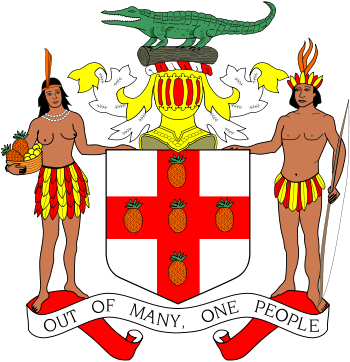Jamaica is the third largest island in the Caribbean, after Cuba and Hispaniola. The country offers an impressive collection of waterfalls, mountain rainforest, beaches and not least a vibrant cultural life. Jamaica is repeatedly named one of the most beautiful islands in the Caribbean.
| Capital: | Kingston |
| Biggest city: | Kingston |
| State: | monarchy within the Commonwealth |
| Language: | English |
| Religion: | Protestantism |
| Surface: | 10,991 km² |
| Population: | 2.7 million (2013) |
| Population density: | 257 residents per km² |
| Life expectancy: | 74 years |
| Illiteracy: | 12% |
| Currency: | Jamaican dollar (JMD) 1 dollar = 0.07 kr |
| GDP per capita: | $ 8,800 (2010) |
| Time difference: | -6 hours |
| Electricity: | 110 V AC, 50Hz |
| National Day: | the first Monday in August |
| Country area code: | 1-876 |
| 2-Letter country abbreviation: | JM (See more abbreviations on Abbreviationfinder) |
| Business: | service sector 63%, agriculture 25%, industry 12% |
| Climate: | tropical; cooler inland |

Jamaica is strongly associated with the reggae and rastafarian movement. World artists such as Bob Marley, Desmond Dekker, Inner Circle, Peter Tosh, Bunny Wailer, Black Uhuru and Sean Paul all come from Jamaica. Both music and religion have had a strong impact on the identity of the residents and on tourism on the island. It is estimated that there are about 30,000 picnics on the island.
From the middle of the 16th century until 1720, Jamaica was used as a stronghold for pirates. The most famous place was the sanctuary of Port Royal where only pirates lived. No one else ventured there. It was called in the 17th century “Wickedest city on earth”. Today, Port Royal is a small fishing village, and a popular tourist destination.
The James Bond films “Agent 007 with the Right to Kill” and “Live and Let Die” are both largely shot on Jamica. The same goes for the movie Papillon with Steve McQueen and Dustin Hoffman, which takes place in a prison colony in French Guiana, but is in fact filmed in Jamiaca.
ELECTRICAL OUTLET
Electricity and electrical outlets in Jamaica
Voltage: 110 V
Frequency: 50 Hz
Type of plug: A, B
Need an adapter: Yes, Swedes need an adapter.
CLIMATE AND WEATHER
Weather in Kingston
| Climate | Jan | Feb | Mar | Apr | May | Jun | Christmas | Aug | Sep | Oct | Nov | Dec |
| Average temperature °C | 27 | 27 | 27 | 27 | 28 | 28 | 28 | 29 | 29 | 29 | 29 | 28 |
| Day °C | 30 | 30 | 31 | 31 | 31 | 32 | 33 | 33 | 32 | 32 | 31 | 31 |
| Night °C | 23 | 23 | 23 | 24 | 25 | 26 | 26 | 25 | 25 | 25 | 24 | 23 |
| Rain (mm) | 20 | 20 | 10 | 30 | 70 | 60 | 40 | 70 | 120 | 130 | 100 | 50 |
| Rainy days | 9 | 7 | 7 | 8 | 11 | 8 | 8 | 10 | 11 | 14 | 11 | 7 |
| Soltim / day | 8 | 8 | 8 | 9 | 9 | 8 | 9 | 9 | 9 | 7 | 7 | 8 |

Kingston
According to Countryaah, Kingston is the capital of Jamaica. The city has 651,880 residents (2001) and is located on the southeast coast of Jamaica. It is a significant port city as well as a trade and industrial center with an international airport.
Trenchtown is one of Kingston’s poorer neighborhoods. Trenchtown was named after the open “sewer” that runs through the entire district. Trenchtown is a typical shanty town, many of the houses are built of sheet metal, wooden boards and other things that the richer Kingston has thrown away. Many great reggae artists have grown up in this neighborhood.
It was in Trenchtown, for example, that reggae artists Bunny Livingstone (Bunny Wailer), Bob Marley and Peter Tosh together with Beverley Kelso, Junior Braithwaite and Cherry Smith started the band The Wailers. Together they wrote the famous song Trenchtown Rock. Bob Marley’s famous song No Woman No Cry is also about life in Trenchtown. Bob Marley’s former home now houses a museum that is the city’s largest tourist attraction.
Montego Bay
Montego Bay is Jamaica’s second largest city, and has the country’s largest international airport. The city has 96,488 residents (2001), and about 200,000 residents with suburbs. Montego Bay is the country’s center of tourism, and one of the Caribbean’s most popular resorts.
The 1973 James Bond film “Live an Let Die” takes place in Montego Bay. A large part of the book “Rule of the Bone” by Russell Banks takes place in Montego Bay.